Students looking for the Bridges in Mathematics Grade 5 Student Book Answer Key Unit 7 Module 4 can find a better approach to solve the problems.
Bridges in Mathematics Grade 5 Student Book Answer Key Unit 7 Module 4
Bridges in Mathematics Grade 5 Student Book Unit 7 Module 4 Session 1 Answer Key
More Decks
Question 1.
Andre, Raven, and their mom are building a deck in the backyard. Here is a sketch of their deck.
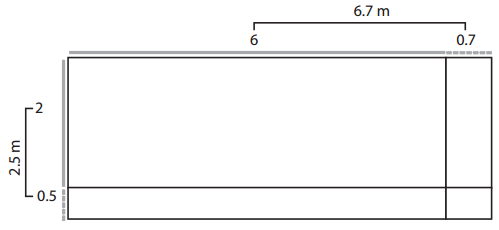
Deck Area = _____________ sq. m
a. Estimate the area of this deck in square meters. Then explain your estimate.
Answer:
The deck is 6.7m long and 2.5m wide.
Since it is rectangular in shape, the area of the deck will be width×length.
The estimated area of the deck will be (2+0.5)+(6+0.7) = 6.7×2.5 = 16.75 sq.m
b. Label the area of each region on the sketch above. Then add the areas of all 4 regions to find the total area of the deck. Show your work beside the sketch.
Answer:
Area of the first rectangle = 6×2 = 12 sq.m
Area of the second rectangle = 6×0.5 = 3.0 sq.m
Area of the third rectangle = 0.7×0.5 = 0.35 sq.m
Area of the fourth recatngle = 2×0.7 = 1.4 sq.m
Total area of the deck will be 12+3.0+0.35+1.4 = 16.75 sq.m

c. Use the partial products method and the standard multiplication algorithm to find the area of the deck.
Partial Products
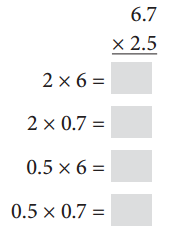
Standard Algorithm

Answer:


Decimals, Powers of Ten & Exponents
In our number system, the value of every place is a different power of 10. Powers of 10 can be represented using exponents, as shown in the chart here.

Places less than 1, such as tenths, hundredths, and thousandths are also powers of 10. These are represented using negative exponents, as shown here.

Most people know that it takes 1 year, or 365 days, for the earth to make one entire trip, or orbit, around the sun. Scientists tell us that the amount of time it actually takes is 365.25 days. Here are four different ways to write the number 365.25.

Question 1.
It takes Mars 686.971 days to orbit the sun one time. Write this number in word, expanded, and exponential form. (The standard form is written in already.)

Answer:

Question 2.
It takes the moon 27.322 days—a little less than a month—to orbit the earth one time. Write this number in word, expanded, and exponential form. (The standard form is written in already.)

Answer:

Bridges in Mathematics Grade 5 Student Book Unit 7 Module 4 Session 2 Answer Key
Decimal Division with Money
Question 1.
Kait spent $9.12 on 6 granola bars. How much did she pay for each one?

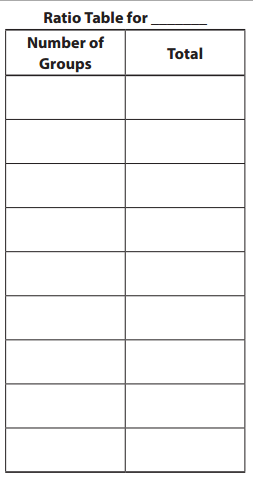
Answer:
Given that Kait spent $9.12 on 6 granola bars.
To calculate the amount spent on each bar, divide 9.12 by 6.
Remove the decimal and divide, which will be 152.
Placing the decimal in the obtained answer, which is 1.52
She paid $1.52 for each bar.

Question 2.
The cash register recorded $3.44 for 4 packages of markers. Kale was going to pay for one of the packages. How much does he owe?


Answer:
Given that the cash register recorded $3.44 for 4 packages of markers. Kale was going to pay for one of the packages.
To calculate the amount she owe, divide 3.44 by 4.
Remove the decimal and divide, which will be 86.
Placing the decimal in the obtained answer, which is 0.86
She owns $0.86.
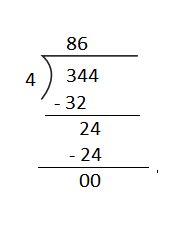
Question 3.
A group of 12 girls went to see a new movie on its opening night. Altogether their entrance fees were $88.20. How much did each girl pay?


Answer:
Given that a group of 12 girls went to see a new movie on its opening night. Altogether their entrance fees were $88.20.
To calculate the amount paid by each girl, divide 88.20 by 12.
Remove the decimal and divide, which will be 732.
Placing the decimal in the obtained answer, which is 7.35
Each girl will pay $7.35.
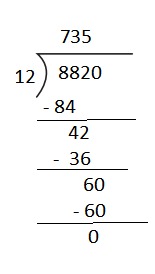
Question 4.
Eight families decided to chip in to buy their team’s practice soccer balls. The bill was $103.92, which was half the regular price. How much should each family pay, if everyone pays a fair share?


Answer:
Given that Eight families decided to chip in to buy their team’s practice soccer balls. The bill was $103.92, which was half the regular price.
To calculate the amount each family will pay, divide 103.92 by 8.
Remove the decimal and divide, which will be 1299.
Placing the decimal in the obtained answer, which is 12.99
Each family will pay $12.99.
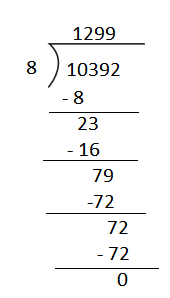
Comparing & Multiplying Fractions & Decimals
Question 1.
Use one of the following symbols to make each expression below true.
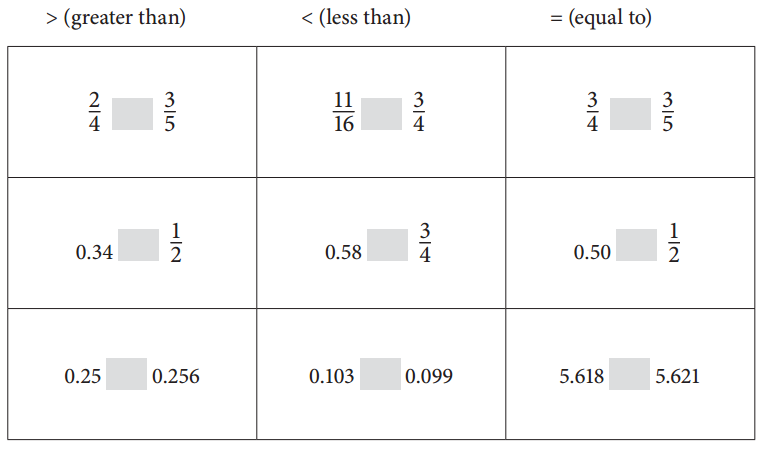
Answer:

Question 2.
Solve these combinations using the strategies that make the most sense to you right now. Show your work.
.025 × 12 = ![]()
56 × 0.50 = ![]()
24 × 0.25 = ![]()
0.25 × 7 = ![]()
48 × 0.25 = ![]()
36 × 0.75 = ![]()
3 × 0.25 = ![]()
0.25 × 9 = ![]()
8 × 0.50 = ![]()
Answer:
Step 1: Remove the decimal and multiply normally.
Step 2: After getting the answer, count and place the decimal point.
.025 × 12 = 25 × 12 = 300
After placing the decimal, 0.300
56 × 0.50 = 56 × 50 = 2800
After placing the decimal, 28.00
24 × 0.25 = 24 × 25 = 6.00
After placing the decimal,
0.25 × 7 = 25 × 7 = 1.75
After placing the decimal,
48 × 0.25 = 48 × 25 = 1200
After placing the decimal, 12.00
36 × 0.75 = 36 × 75 = 2700
After placing the decimal, 27.00
3 × 0.25 = 3 × 25 = 75
After placing the decimal, 0.75
0.25 × 9 = 25 × 9 = 225
After placing the decimal, 2.25
8 × 0.50 = 8 × 50 = 400
After placing the decimal, 4.00
Bridges in Mathematics Grade 5 Student Book Unit 7 Module 4 Session 3 Answer Key
Using Models & Strategies
Question 1.
If school lunches cost $112.50 per quarter (9 weeks), about how much would each week of lunches cost?


Answer:
Given that the school lunches cost $112.50 per quarter (9 weeks)
To calculate the cost per quarter, divide 112.50 by 9.
Remove the decimal and divide, which will be 1250.
Placing the decimal in the obtained answer, which is 12.50
For each quarter they will pay $12.50.
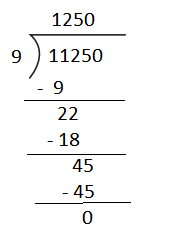
Question 2.
A fifth grader earned $94.00 gardening this month for a neighbor. If she worked 8 hours this month, then how much did she earn per hour?
Answer:
Given that a fifth grader earned $94.00 gardening this month for a neighbor. She worked 8 hours this month.
To calculate the amount she earned per hour, divide 94 by 8.
Dividing 94 by 8 will give, 11.75
She will earn $11.75 per hour.
Question 3.
Marcy joined the school track team and ran a total of 231.80 miles in practice over 61 days. How many miles did she average per day?
Answer:
Given that Marcy joined the school track team and ran a total of 231.80 miles in practice over 61 days.
To calculate the miles, divide 231.80 by 61
Dividing 23180 by 61 will give, 380
Placing the decimal will give 3.8
She will run 3.8 miles on average per day.
Question 4.
A store owner had 7.11 lbs. of nuts left in the bin. If he divided the nuts evenly into 9 jars, how much did the nuts in each jar weigh?
Answer:
Given that a store owner had 7.11 lbs. of nuts left in the bin. If he divided the nuts evenly into 9 jars.
To calculate the nuts in each jar, divide 7.11 by 9.
Dividing 7.11 by 9, it will give 0.79
Each jar will weigh 0.79 lbs.
Question 5.
There are 2.54 centimeters in one inch. How many centimeters are in 38.10 inches?
Answer:
Given that 2.54 centimeters in one inch.
Common Division Mistakes
Help the following students sort out their misunderstandings about division.
Question 1.
Su has to solve 8 ÷ \(\frac{1}{7}\). She says the answer is \(\frac{8}{7}\). What would you tell Su about her thinking? What is 8 ÷ \(\frac{1}{7}\)?
Answer:
Given that Su has to solve 8 ÷ \(\frac{1}{7}\).
8 × \(\frac{7}{1}\)
56
Her answer is incorrect.
Question 2.
Zane has to solve \(\frac{1}{2}\) ÷ 4. He says the answer is 2, because that’s half of 4. What would you tell Zane about his thinking? What is \(\frac{1}{2}\) ÷ 4?
Answer:
Given that Zane has to solve \(\frac{1}{2}\) ÷ 4
\(\frac{1}{2}\) ÷ 4
4 × 2
8
He is incorrect.
Question 3.
Irene wants to use equivalent ratios to solve 3,712 ÷ 64, but she can’t remember how. Show Irene what to do.
Answer:
Given that Irene wants to use equivalent ratios to solve 3,712 ÷ 64,
Dividng will give 58.
Bridges in Mathematics Grade 5 Student Book Unit 7 Module 4 Session 4 Answer Key
Reviewing Decimal Addition & Subtraction
Question 1.
Complete the following addition problems.

2.45 + 1.469 = ______________
3.043 + 1.588 = ______________
Answer:

2.45 + 1.469 = 3.919
3.043 + 1.588 = 4.631
Question 2.
Complete the following subtraction problems.

5.604 – 3.025 = ______________
6.045 – 2.039 = ______________
Answer:

5.604 – 3.025 = 2.579
6.045 – 2.039 = 4.006
Question 3.
Circle the pairs of numbers whose sums are greater than 2.
1.26 + 0.773
1.255 + 0.094
1.53 + 0.458
1.502 + 0.6
Answer:
1.26 + 0.773 = 2.033
1.255 + 0.094 = 1.349
1.53 + 0.458 = 1.988
1.502 + 0.6 = 2.102
Thus, 1.26 + 0.773 and 1.502 + 0.6 are the pairs of numbers whose sums are greater than 2.